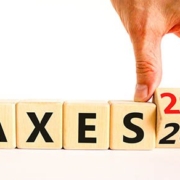The Treasury Green Book of Biden-Proposed Tax Changes
- Learn about proposed changes to long-term capital gains rates.
- Find out how the Green Book may increase the top individual tax rate.
- Learn more about the possibility of pass-through income being subjected to 3.8% NIIT or SECA tax.
- Discover how the Green Book could further limit nonrecognition of like-kind exchanges.
- Learn about the changes proposed for the transfer of appreciated property by gift or death.
- Find out how the payment of tax on the appreciation of family-owned and -operated businesses may change.
- Learn about the 15-year fixed-rate payment plan on appreciated assets transferred at death.
- Find out how changes may affect the excess business loss limitation.
- Discover what tax changes will mean for carried interest.
- Learn about enhanced financial account reporting for banks and other financial institutions.
The U.S. Treasury has released the Biden administration’s 2022 Fiscal Year Budget. It includes a general explanation of the administration’s 2022 revenue proposals. We commonly refer to the publication as the Green Book, and it outlines the Biden administration’s tax proposals. Keep in mind that these are proposals and will have to be passed by Congress. The Green Book proposals include both domestic and international taxes; however, this article will only cover domestic tax issues that deal with individuals and small businesses. Also included in the Green Book are proposals to extend, expand or create new energy-related tax credits; Fiducial has not included any of these proposals in this article.
Long-Term Capital Gains Rates
Currently, long-term capital gains and qualified dividends are taxed at the following rates.
CG TAX RATES BY AGI RANGE FOR 2021

The Green Book proposals would increase the tax rate for long-term capital gains and qualified dividends to 39.6% (the proposed increase to the top individual rate) from the current 20% rate to the extent the taxpayer’s AGI exceeds $1 million. That will result in a tax as high as 43.4% when including the 3.8% net investment income tax imposed on investment income of middle- to higher-income taxpayers. The proposal suggests making the retroactive rate change effective for gains and income recognized after April 28, 2021.
Example: Under the proposal, a taxpayer with $900,000 of wage income and $200,000 of long-term capital gain income would have $100,000 of capital income taxed at the current preferential tax rate and $100,000 taxed at ordinary income tax rates.
The Green Book Raises the Top Individual Tax Rate
The Green Book proposes an increase in the top individual rate from the current 37% to 39.6%. This will return the top rate to where it was before the passage of the TCJA. Note: under the TCJA, the 37% rate applies only through 2025. The table below shows the taxable income threshold for the top tax rate in 2021. Only income above that level is taxed at the top tax rate. Tax rate brackets are currently adjusted annually for inflation. The proposed 2022 thresholds will be inflation-indexed in future years.

*top rate applies to taxable income above these amounts
Pass-Through Income Subject to 3.8% NIIT or SECA Tax
Under current law, S-corporation shareholders and limited partners do not pay self-employment tax on pass-through income. However, the Green Book proposes changing that for high-income taxpayers with adjusted gross income of more than $400,000.
The proposal would ensure that all trade or business income of high-income taxpayers is subject to the 3.8 percent Medicare tax. This would occur either through the net investment income tax (NIIT) or the Self-Employment Contributions Act (SECA) tax.
- The proposal would expand the NIIT base to include income and gain from trades or businesses not otherwise subject to employment taxes. The 3.8% NIIT tax would also be redirected to the Hospital Insurance Trust Fund.
- The 3.8% SECA tax would apply to the ordinary business income of high-income non-passive S corporation owners. This refers to those whose AGI is greater than $400,000.
- Limited partners and LLC members who provide services and materially participate in their partnerships and LLCs would be subject to SECA tax on their distributive shares of partnership or LLC income to the extent that this income exceeds certain threshold amounts. The exemptions from SECA tax provided under current law for certain types of S corporation income (e.g., rents, dividends and capital gains) would continue to apply to these types of SECA income.
Material participation standards would apply to individuals who participate in a business in which they have a direct or indirect ownership interest. Material participation includes taxpayers who regularly take part in the business in a regular, continuous and substantial way. Often, this means they work for the business for at least 500 hours per year. The statutory exception to SECA tax for limited partners would not exempt a limited partner from SECA tax if the limited partner otherwise materially participated.
SECA
To determine the amount of partnership income and S corporation income that would be subject to SECA tax under the proposal, the taxpayer would sum:
(a) ordinary business income derived from S corporations for which the owner materially participates in the trade or business and
(b) ordinary business income derived from either limited partnership interests or interests in LLCs classified as partnerships to the extent a limited partner or LLC member materially participates in its partnership’s or LLC’s trade or business (we refer to this sum as “potential SECA income”).
Beginning in 2022, the additional income that would be subject to SECA tax would be the lesser of:
(i) the potential SECA income or
(ii) the excess over $400,000 of the sum of the potential SECA income, wage income subject to FICA under current law, and 92.35 percent of self-employment income subject to SECA tax under current law.
The $400,000 threshold amount would not be indexed for inflation.
Green Book Limits Nonrecognition of Like-Kind Exchanges
The TCJA did away with all Sec 1031 “like-kind” exchanges (tax-deferred exchanges) except those related to real property. The Green Book proposes going a step further. It would limit eligibility for Section 1031 exchanges. This would occur by permitting each taxpayer to defer only up to $500,000 ($1 million for married taxpayers filing jointly) of real property gain each year. Any gain more than the $500,000 ($1 million) limit would qualify as taxable income in the taxable year in which the taxpayer transfers the real property.
These changes would require REITs to distribute gains on property sales that could otherwise be deferred under Section 1031. Caution: The proposal would apply these rules to exchanges “completed after taxable years beginning after December 31, 2021.” You may complete deferred exchanges in 2022. However, please realize that the property given up may have been transferred in 2021, and thus may qualify as taxable in 2021.
Transfer of Appreciated Property by Gift or Death
The Green Book proposes changes to the rules for a gift donor or a deceased owner if an appreciated asset would realize a capital gain at the time of the transfer. The capital gain would equal the excess of the asset’s fair market value (FMV) on the date of a deceased owner’s death (or the date the gift is given) over the decedent’s or donor’s basis in the property.
The resulting gain would be taxable income for the decedent. They would need to report this on a Form 709 Federal Gift Tax Return, Form 706 Estate Tax Return or a separate capital gains return.
These changes would be effective for gains on property transferred by gift, property owned at death by decedents dying after December 31, 2021 and certain property owned by trusts, partnerships and other non-corporate entities on January 1, 2022.
Determining Fair Market Value
To determine an asset’s FMV, you must use normal gift or estate tax methodologies. However, for this tax on appreciated assets, the following would apply:
- Partial Interests – The FMV of a partial interest will be based upon a proportional share of the FMV of the entire property.
- Transfers – Transfers of property into and distributions in kind from a trust, partnership or other non-corporate entity (other than a grantor trust deemed wholly owned and revocable by the donor) would qualify as recognition events.
The deemed owner of a revocable grantor trust would recognize gain on the unrealized appreciation of any asset distributed from the trust to any person other than the deemed owner or the U.S. spouse of the deemed owner, other than a distribution made in discharge of an obligation of the deemed owner. All of the unrealized appreciation on assets of such a revocable grantor trust would be realized at the deemed owner’s death or at any other time the trust becomes irrevocable.
90-year rule
Gain on unrealized appreciation would also be recognized by a trust, partnership or other non-corporate entity that is the owner of the property if that property has not been the subject of a recognition event within the prior 90 years. The testing period for this provision would begin on January 1, 1940. Thus, the first possible recognition event under this provision would be December 31, 2030.
Exclusions
Certain exclusions apply to the foregoing gain recognitions.
Transfers to a spouse or charity
Transfers by a decedent to a U.S. spouse or charity would have the following effects:
- The basis of the decedent would carry over to the spouse or charity.
- Recognition of the capital gain would not occur until the surviving spouse disposes of the asset or dies.
- Appreciated property transferred to charity would not generate a taxable capital gain.
- Transfer of appreciated assets to a split-interest trust would generate a taxable capital gain. This would include an exclusion allowed for the charity’s share of the gain based on the charity’s share of the value transferred as determined for gift or estate tax purposes.
Tangible property and principal residence
The proposal would exclude from recognition any gain on tangible personal property. This includes household furnishings and personal effects (excluding collectibles). The $250,000 per person exclusion under current law for capital gain on the sale of a principal residence would apply to all residences. It would also be portable to the decedent’s surviving spouse, making the exclusion effectively $500,000 per couple.
Small business stock
The exclusion under current law for capital gain on certain small business stock under Code Sec. 1202 would continue to apply.
New $1 million exclusion
The Green Book proposal would also allow a $1 million per-person exclusion from recognition of other unrealized capital gains on property transferred by gift or held at death. Inflation-adjustment will take place after 2022. Thus, for a married couple, the exclusion would be $2 million.
- The recipient’s basis in property received by reason of the decedent’s death would be the property’s FMV at the decedent’s death.
- In the case of a gift, the recipient’s basis equals the donor’s basis less any amount excluded by the donor using the $1 million exclusion.
- Also, in the case of a gift, the donor would be subject to tax on unrealized gain less any amount excluded by the donor’s $1 million exclusion.
Family-Owned and -Operated Businesses
Payment of tax on the appreciation of certain family-owned and -operated businesses would not come due until the interest in the business is sold or the business is no longer family-owned and -operated.
15-Year Fixed-Rate Payment Plan
Furthermore, the proposal would allow a 15-year fixed-rate payment plan for the tax on appreciated assets transferred at death. This does not apply to liquid assets, including publicly-traded financial assets and businesses for which the deferral election is made. The IRS would be authorized to require security at any time if there is a reasonable need for security to continue this deferral. That security may be provided from any person, and in any form, deemed acceptable by the IRS.
Excess Business Loss Limitation
We define excess business loss as the excess of losses from business activities over the sum of (a) gains from business activities and (b) a specified threshold amount. In 2021, these thresholds are $524,000 for married couples filing jointly and $262,000 for all other taxpayers. Thereafter, these amounts are indexed for inflation. The determination of excess business loss occurs at the taxpayer level, aggregating across all business activities. However, gains or losses attributable to any trade or business of performing services as an employee do not qualify. This provision will expire after 2026.
The Green Book proposal would make the excess business loss limitation permanent for non-corporate taxpayers.
Corporate Tax Rate
Before the TCJA of 2017, the highest marginal tax rate that applied to corporations was 35%. The Green Book proposes raising the corporate tax rate from the current 21% to 28%. The proposal would be effective for tax years beginning after 2021. However, there has been some news that the Biden administration may be willing to compromise on this issue. That would leave the rate at the current 21%.
Also proposed: a 15% minimum tax on the book earnings of certain large corporations.
Carried Interest
The proposal would generally treat partnership income from carried interests as ordinary income subject to self-employment tax. Currently, this type of income is eligible for preferential long-term capital gains rates.
Enhanced Financial Account Reporting
The proposal includes a new comprehensive financial account information-reporting regime for banks and other financial institutions beginning in 2023. Financial institutions would have to report gross inflow and outflow of accounts to the IRS annually. They would need to include a breakdown for physical cash, transactions with foreign accounts and transfers to and from another account with the same owner. Similar reporting requirements would apply to crypto asset ex-changes and custodians.
While the purpose of this provision, as explained in the Green Book, is to provide more data to the IRS so they will have better “visibility of gross receipts and deductible expenses” of businesses, this requirement would apply to all business and personal accounts from financial institutions. This includes bank, loan and investment accounts, except for accounts below a gross flow threshold or FMV of $600.
Many provisions included in this article are complicated, and not all of the Green Book proposals have been covered. Remember, these provisions are the Biden administration’s wish list and may not become law as outlined in the Green Book. Feel like you need additional information? Call Fiducial at 1-866-FIDUCIAL or make an appointment at one of our office locations to discuss your situation.
Ready to book an appointment now? Click here. Know someone who might need our services? We love referrals!
For more small business COVID-19 resources, visit Fiducial’s Coronavirus Update Center to find information on SBA loans, tax updates, the Paycheck Protection Program, paid sick and family leave









